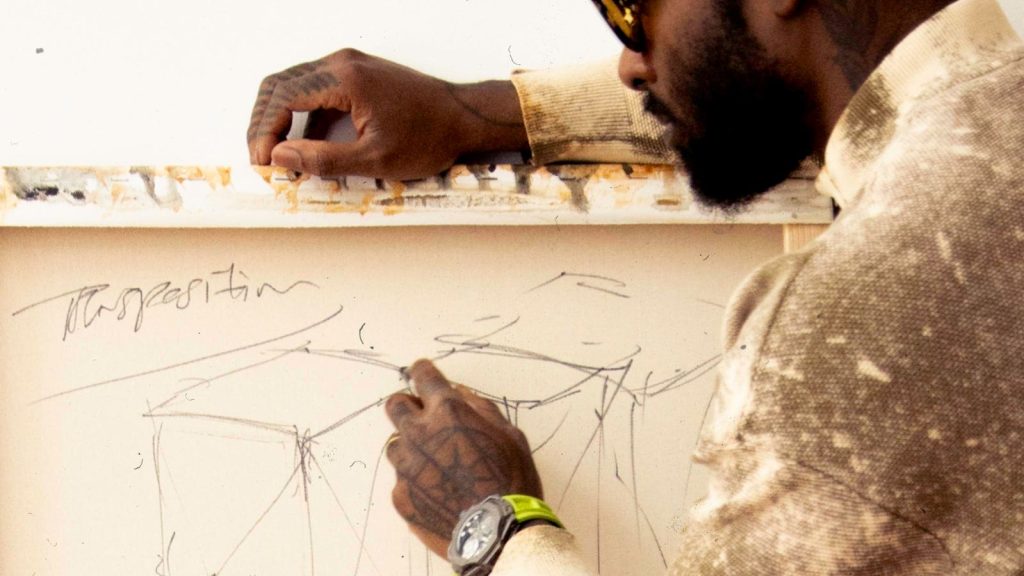The Balvenie commissions multidisciplinary artist Samuel Ross for “Transposition” at Milan Design Week 2025
SR_A (Samuel Ross & Associates)
Samuel Ross is, to my mind, among the most exciting contemporary creatives. His multidisciplinary practice spans fashion, industrial design, sculpture, installation art and graphic design. He’s been awarded two doctorates, has artworks in the MoMA and V&A permanent collections, he’s had solo exhibitions at White Cube and Friedman Benda, and created innovative wearable objects for the likes of LVMH, Apple and Nike.
Ross is very much of this current generation of creatives who carry the weight of socioeconomic challenges and the richness of cultural complexity to inform their creative thinking. In his case, this means exploring themes of social architecture, materiality and cultural identity for an often evocative and sometimes surprising lens through which to view our world. He sits comfortably within a generation of creatives who move fluidly between disciplines, allowing one to explore the other for a certain freedom of expression.
For this year’s Milan Design Week and Fuorisalone (April 7 to April 13, 2025), Ross, alongside his atelier SR_A (Samuel Ross & Associates), teamed with The Balvenie to create “Transposition”—a site-specific installation exploring the alchemy of whisky. Set within Historic Foundry in the city’s Isola district, the work invited visitors into a sensory landscape of vertical rivers, interwoven sounds and shifting reflections, inviting us to explore new ways of seeing and experiencing.
“Transpositon” installation in the historic Foundry in Isola in Milan as part of Milan Design Week 2025
Francesco Stelitano/The Balvenie
The Balvenie was founded in 1882 by William Grant in Dufftown, Scotland. The distillery continues to use traditional whisky-making processes passed down through generations, and it remains one of the few Scotch producers to grow its own barley, maintain traditional floor maltings, as well as employ in-house coppersmiths and coopers.
Ross came up with the concept behind “Transposition” on visit to The Balvenie. Inspired by the dramatic landscape and the distillery’s reverence for craft and innovation, he set out to challenge the romanticized tropes of whisky, instead connecting craft and the natural and industrial worlds.
The Historic Foundry’s raw industrial atmosphere also inspired the installation. Copper frames reference The Balvenie’s distillation process, brutalist forms nod to the distillery’s architecture, and mist, light and sound call the slow, transformative maturation of The Balvenie Fifty Collection. As a final touch, Ross’s signature yellow punctuating the space acts as a symbol of hope and innovation.
I asked Ross about his creative thinking for “Transposition,” and what drew him to collaborate with The Balvenie.
Dr Samuel Ross MBE at his studio
SR_A (Samuel Ross & Associates)
Nargess Banks: What initially drew you to The Balvenie, and what about the brand resonated with your design philosophy?
Samuel Ross: Balvenie’s commitment to craft. Their respect for tradition, the approach to producing with intent. It mirrors my own philosophy in the arts.
NB: How did you approach this collaboration creatively?
SR: My intent was to project the whisky-making process into an immersive installation. “Transposition” features large copper structures with flowing water, these “vertical rivers” speak to the ideas of perpetual movement, distillation and patience that are embedded in The Balvenie’s methods. It’s a reflective sensory artwork.
The work invited visitors into a sensory landscape of vertical rivers, interwoven sounds and shifting reflections
Francesco Stelitano/The Balvenie
NB: The Balvenie values craftsmanship and heritage. How did those ideas influence your design process for this project?
SR: Copper became a key material, not just for its industrial feel but for its relevance to distillation. All is in dialogue with their heritage, interpreted through a new way of reflecting the feeling of an atelier.
NB: What did you discover through this partnership: about materials, process, or even yourself?
SR: Slowing down, engaging more deeply with the passage of time.
NB: You have worked on a number of cross-disciplinary collaborations. How do projects like this shape or inform your wider creative practice?
SR: They keep things open, fluid. Collaborations encourage the move between disciplines, design, architecture, fine art and to project methods from each. These intersections are where the most interesting ideas emerge.
The choice of Milan’s Historic Foundry as a setting is purposeful, its raw industrial atmosphere mirroring the installation’s exploration of material and mindset.
Francesco Stelitano/The Balvenie
NB: How important is storytelling to your design work?
SR: Every material, every form, every spatial decision, it’s all in service of a narrative. With “Transposition” the story is one of transformation, of labour, of history. You want people to walk away with something they can feel, not just see.
NB: Salone del Mobile and Fuorisalone offers an influential platform for design and culture. Did the Milan setting impact your vision for the project?
SR: Definitely, Milan is such a vital city when it comes to design. The space itself, a former foundry in the Isola District, brought another layer to the installation. Its industrial character felt completely in tune with the themes we were exploring.
NB: What do you hope people take away from experiencing this installation—emotionally, intellectually, or perhaps materially?
SR: A quiet awe to reflect on the relationship between tradition and expression. It is more so about the feeling, one that can exist only in a physical space.
NB: How do you see the future of craft evolving, and what role do designers like yourself play in shaping that narrative?
SR: It’s not simply about preserving old techniques—it’s about creating new contexts for them. Artists and designers have a crucial role in that.
Read my highlights from Milan Design Week 2025; see what’s happening at the 24th Triennale Milano here, and read my year in art.
For more articles on art and design, visit my page here.

